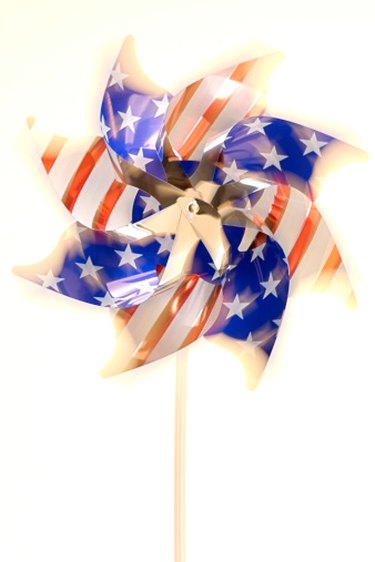
The pinwheel is a type of whirligig. The primary requirement for a whirligig is at least one part of the object spins due to the power of wind, friction, hand movement or a motor. Attached to a stick, the blades of the pinwheel fold inward, cupping the wind and causing the blades to spin rapidly almost as soon as the wind hits them. The pinwheel has a long history that spans the globe.
Origins
Video of the Day
The first inventor of the whirligig, or pinwheel, is not known. However, history does indicate wind-driven whirligigs existed in China in 400 BC and in the Sasanian Empire by 700 AD, with the use of windmills. Weather vanes, closely related to pinwheels, were first used between 1600 and 1800 BC in Sumeria. By the 15th century whirligigs were shown in paintings, such as the Hieronymus Bosch painting, "Christ Child With a Walking Frame," circa 1480 to 1500.
Video of the Day
Pinwheels in America
Pinwheels may have arrived in America by way of immigrants from Europe. The first recorded evidence of their existence in the U.S. is related to George Washington, who carried whirligigs home from the Revolutionary War. By the 18th century wooden, wind-driven whirligigs existed as weather vanes with moving parts set in motion by the wind. By the time of the Great Depression in 1929, however, individuals handmade and sold wind-driven whirligigs as garden ornaments or children's entertainment as a means of making a living.
Pinwheels in China
For the Chinese New Year it is tradition that artists construct extravagant pinwheels with multiple colors. Around the outer blades of these pinwheels the Chinese artists place handwritten messages focusing on long life, good health, wealth or luck. As the pinwheels spin these messages are caught by the wind and sent into the universe as a wish for the coming year.
Today
Today pinwheels are commonly found throughout the U.S. in department and dollar stores in many shapes and sizes and used as inexpensive entertainment for kids. Pinwheels are also made primarily out of plastic, with vibrant colors for holiday celebrations, such as Memorial Day and the 4th of July. Additionally, a custom for some people is to place a pinwheel at the grave of a loved one, suggesting the pinwheel represents the freedom of the spirit.